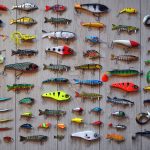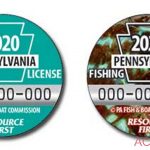BY TYLER FRANTZ
Spring fishing weather can be as unpredictable as a meteorologist’s seven-day forecast.
Bluebird days, overcast skies and even rain, wind and snow offer challenges as well as advantages when it comes to trout fishing opportunities.
Still, hard-core fishermen are going to hit the water regardless of weather conditions, knowing they can boost their odds by being flexible and adapting to whatever Mother Nature throws at them. Consider this a weatherman’s guide to adaptable all-weather angling.
Sunny days
Sunlight can be both a blessing and a curse. When water is clear, sunny days allow wading stream anglers to sight-fish, or pick out the exact fish they wish to target, laying in pools or near cover. However, it also casts longer shadows, which can spook fish since their natural instincts tell them to flee from overhead prey. To avoid this, approach the stream from a low angle to the ground or from the side of the stream opposite the sun so your shadow will not be exposed over the water. Wear polarized sunglasses to combat harsh glares, and target fish in shaded haunts where they feel more secure, taking refuge from the overhead sun.
Windy days
Fly anglers know better than anyone how much wind can affect a long cast. On windy days, it can be difficult to place presentations exactly, but it also means fish will anticipate more food being blown into the water.
Consider tying on a terrestrial pattern such as a beetle, ant or inchworm and cast quartering into the wind near streamside cover to take advantage of the feeding frenzy that is below. Don’t worry about perfect placement, but be mindful to mend the line to ensure a drag free drift.
On the open water, wind also can impact boat control — especially on smaller vessels. Trolling on breezy days allows covering more water, while utilizing the motor’s steady force to maintain better control of the boat. If winds become gusty to the point of causing choppy water conditions, it’s best to head for shore.

SUBMITTED PHOTO
Spring fishing weather can be as unpredictable as a meteorologist’s seven-day forecast.
Snow/sleet mix days
Believe it or not, fish can be caught in a late spring snow squall, but it makes the fishing a little tricky, especially a day or two after a snowmelt, when the sharp change in water temperature seems to turn off the bite. Try fishing with a little flash, such as an inline spinner, streamer of colorful egg pattern to prompt an aggressive strike from lethargic fish.
Sleet is one of the few precipitation sources that often discourage anglers, as the rod’s line guides tend to ice up quickly, it’s uncomfortable to be out there, and banks can get slippery, posing a dangerous threat for water submersion and potential hypothermia.
Rainy days
Few weather changes can turn on a bite like a passing shower. There’s something about that stimulation on the water’s surface that makes fish want to cooperate and feed aggressively.
As long as there is no lightning and thunder, be prepared to stick out an on-and-off rainstorm or steady drizzle by keeping a lightweight rain jacket in a fishing vest or tackle bag. The fish certainly don’t mind getting wet, and for anglers who don’t mind it either, they’ll likely be rewarded for their determination.
Following a good washout, however, it can be very difficult to catch fish. With high water levels and stained or milky turbidity, use heavily scented baits or simply wait for the water to clear.
Cloudy/overcast days
For many their all-time favorite weather for fishing is when skies are overcast and temperatures remain cool. Big fish become more brazen and begin to cruise around in search of an opportunistic meal.
Take advantage of this predatory activity by offering them what they want. Sometimes it comes in the form of a top-water plug, or a soft plastic bounced along the bottom, or even live bait suspended right in the middle of the water column.
Where there is one fish, there is often more, so when finding the right stuff on an overcast day and the fish respond positively, keep giving them the same thing until it wears them out. Many times, the fight draws attention and brings more willing participants to the show, and multiple encores can be had under a cloudy curtain call.
Remaining adaptable and willing to use various angling techniques allows one to fish in virtually any of Pennsylvania’s rapidly changing weather conditions. Rain or shine, being an all-weather angler means more time on the water, regardless of the weatherman’s outlook.
Frantz is president of the Pennsylvania Outdoor Writers Association. Contact him a outdoors@republicanherald.com.




